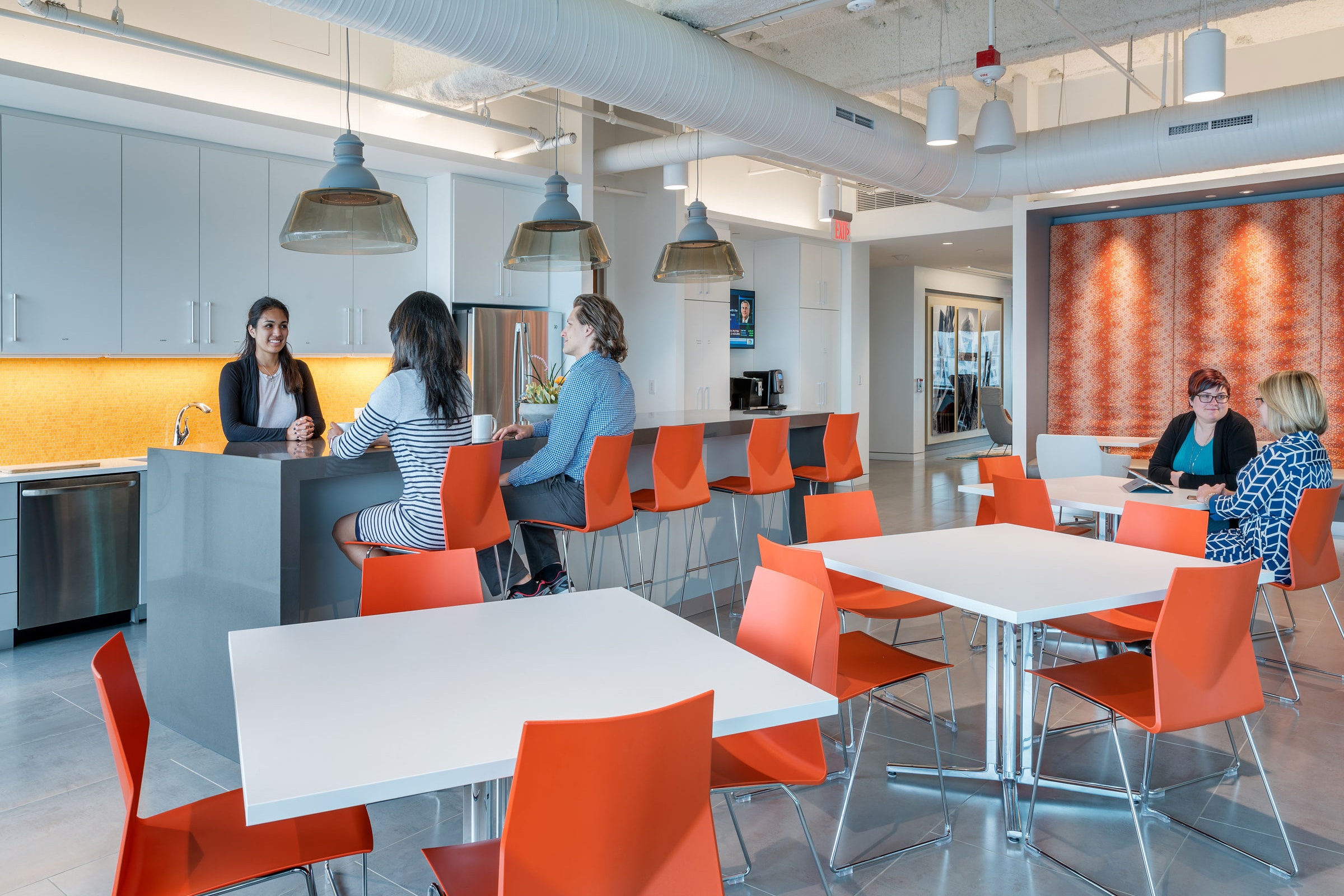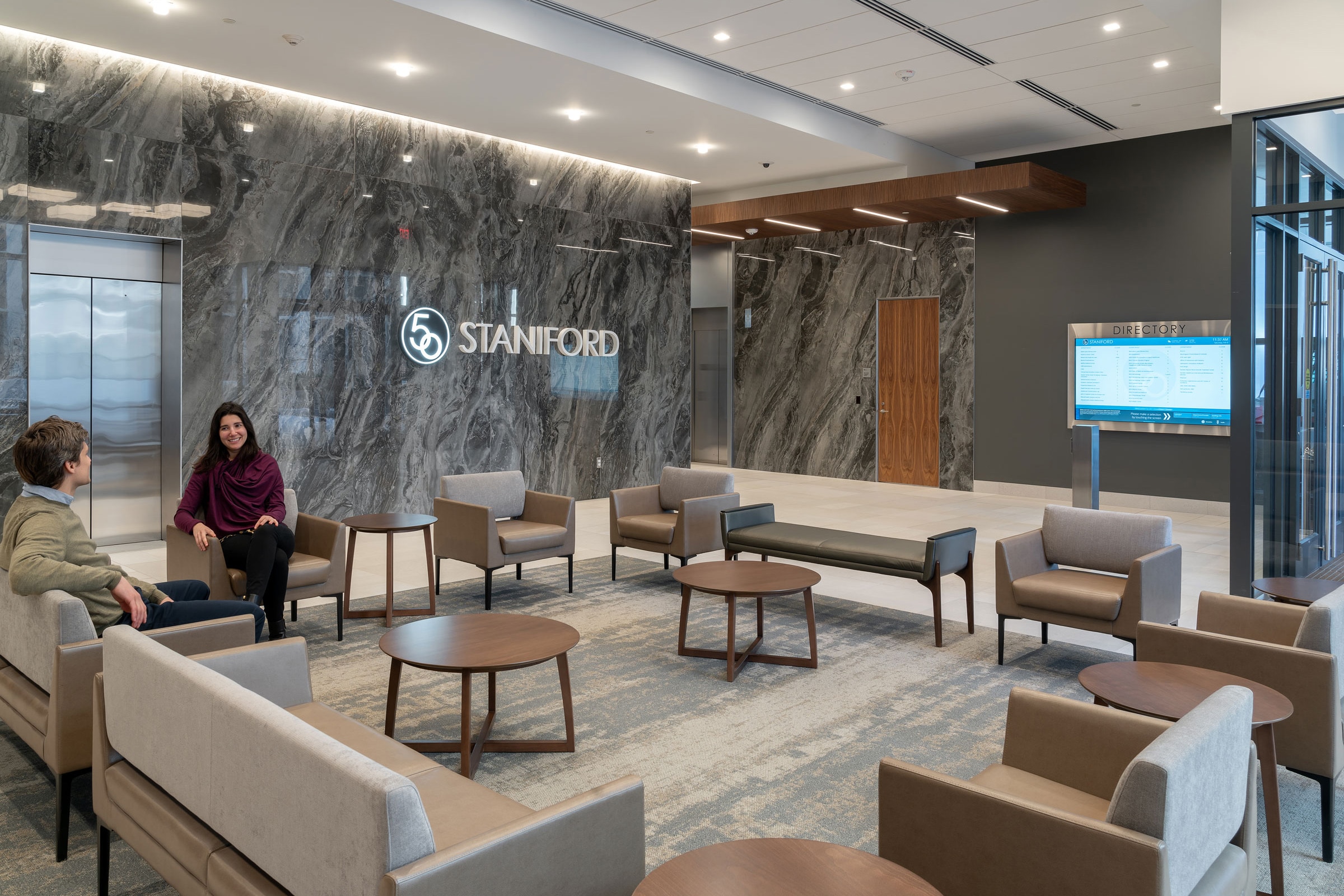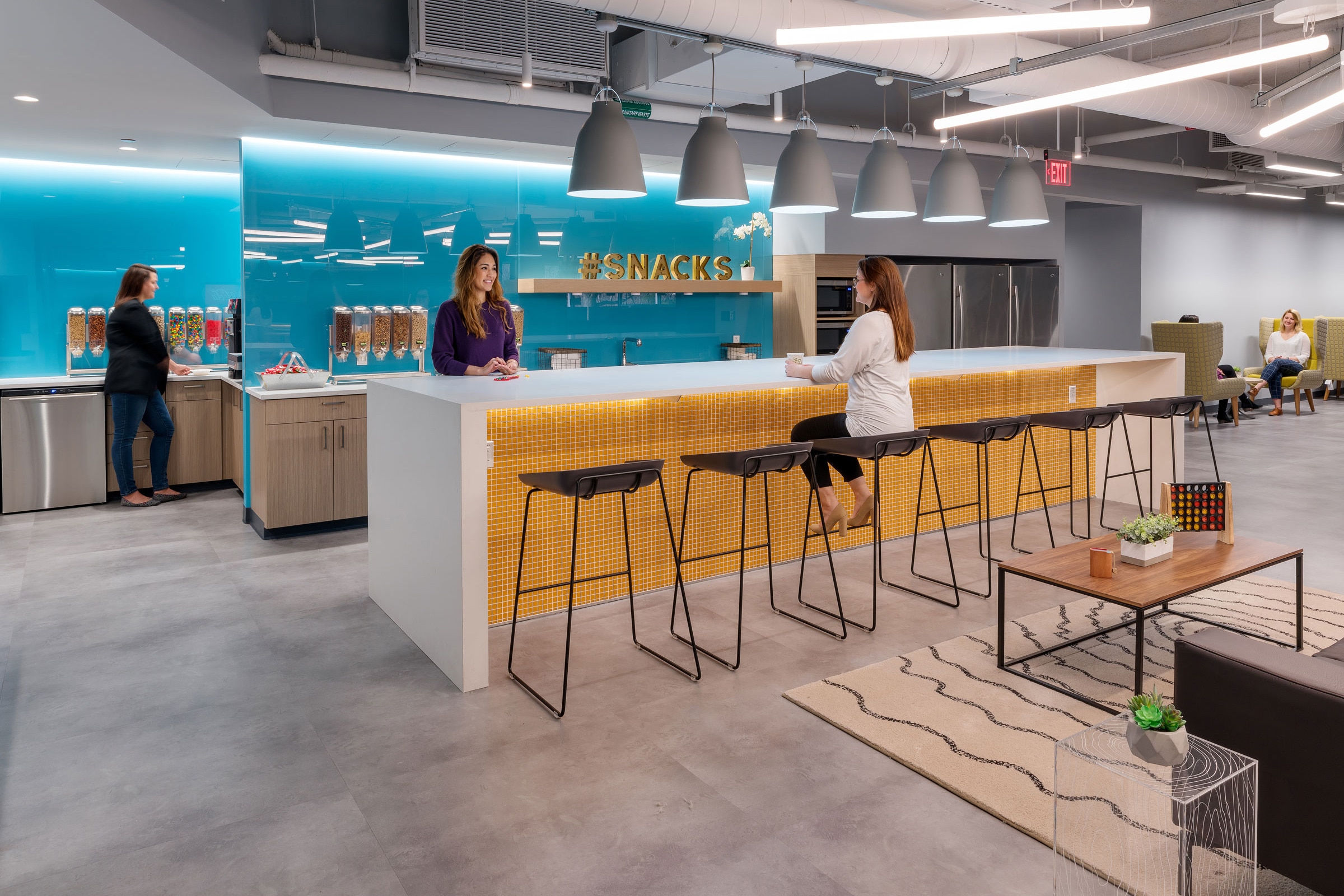When selecting interior products, their ability to heighten wellness and the ease and effectiveness of maintaining them is essential. With the return to the office pending for many employees post-COVID-19, facility managers and property managers are being asked to demonstrate an increased cleaning regime for high-touch areas in the workplace. Additionally, many are also rethinking the interior products being used within their workspace and whether to incorporate anti-microbial products.
There are many products and cleaners that promote anti-microbial qualities, but not all may offer the result you are seeking, nor will some anti-microbial interior finishes withstand the increased application of cleaning solvents. While the CDC recently reported that it is not likely you can pick up the virus from surfaces, they still recommend hand-washing and disinfecting surfaces. For interior designers that means taking cues from the health care industry and the EPA on the best products with biocide qualities.
Here are a few key things you need to know when selecting anti-microbial interior products for the post-COVID-19 workplace:
- Not all anti-microbial products are both anti-bacterial and anti-viral.
- Anti-microbial products need time to be effective.
- Most anti-bacterial coatings slow the rate of growth of germs versus killing them.
- Many anti-microbial products have impacts on the environment and human health.
Recommended Solution: Inherently Anti-Bacterial Products
Nonporous products like solid surfaces, quartz, and XOREL inherently inhibit the growth of bacterial, though they are not necessarily anti-viral. Metal ion products like pure silver and copper have been shown to be effective against bacteria and certain viruses. Studies show the COVID-19 virus can survive on copper up to four hours versus stainless steel, which can carry the virus for 10.
Although silver and copper metal do not lose their anti-bacterial properties over time, these products should not be your primary defense against bacteria and viruses. Studies have found that inherently anti-bacterial products present low human health risks, but there is debate on whether there is an increase in anti-bacterial resistance. Care needs to be taken when cleaning some of these products, as the increased use of acidic or abrasive cleaners, including bleach, can discolor or disintegrate the product.

Avalon Bay’s LEED Gold Boston office includes an employee lounge with quartz surface countertops, high-performance textiles, and solid-surface table tops that aid in easy maintenance and reducing bacteria growth. Photo courtesy of Margulies Perruzzi
Some common interior products that are inherently anti-bacterial include:
Solid Surfaces
Some materials like solid surface Krion are nonporous, anti-bacterial without any type of additive, hard-wearing, highly resistant, easy to repair, require minimum maintenance, and are easy to clean. Many solid surfaces can be disinfected occasionally using diluted bleach.
Soapstone and Quartz
Both soapstone and engineered stones, also known as quartz surfaces, are highly resistant to bacteria and stains because they are nonporous. Some quartz specifically adds an anti-bacterial agent, Triclosan, to its surfaces. Although Triclosan can be found in many soaps, the Healthier Hospitals Initiative bans its use. They have found the wide use of the chemical can be toxic to humans. Studies show it is not as effective in real world versus lab settings. You should avoid using any acidic or abrasive cleaners on quartz, as it will cause discoloration or disintegration. Lysol wipes may be acceptable for quick cleaning if they are bleach-free, but use them sparingly.
Xorel
This textile can be used on walls, panels, and upholstery. It is inherently anti-microbial, bleach-cleanable, and stands up to abuse in high-traffic areas.
Copper Metals
Copper is making a comeback after falling out of fashion years ago. It can be found in hospitals as well as professional sport teams training rooms and restaurant bathrooms to combat the spread of microbes. The EPA confirmed pure copper has anti-microbial properties effective in killing bacteria and has been shown to kill norovirus. Testing has found copper begins to eliminate germs upon contact and eliminating up to 99.9% of harmful bacteria within two hours. However, imported copper is being manufactured using annealed recycled copper, not pure copper. This practice lowers the anti-microbial benefits. Although there is a premium for copper finishes, interior products such as door handles, railings, light switches, sinks, and faucets can all be made in copper finishes.
Silver Metals
Silver is recognized to have antimicrobial qualities. Silver itself is known to be nontoxic to humans.

MPA’s lobby renovation at 50 Staniford incorporates many lessons learned from the health care industry: bleach cleanable and anti-bacterial fabrics, nonporous finishes, and tables with a smooth finish and cleanable top coat. Photo courtesy of Margulies Perruzzi
Where to Use Caution: Anti-Bacterial Coatings and Infused Products
Studies (AATCC 147) have shown a lack of measurable and documented results that anti-microbial additives in interior textiles prevent infection. Many manufacturers note the use of anti-bacterial additives is typically used as a coating to preserve the products’ surface from damage and degradation caused by micro-organisms rather than preventing the spread of infection.
Some interior products that offer anti-bacterial finishes include:
Silver Ion Film
Anti-microbial films like Silver Defender are adhesive films with anti-microbial protection incorporated into the film. The silver in the film helps maintain a clean film surface and lasts for 90 days before needing to be replaced.
Textile
Some non-woven and coated fabrics like vinyl, polyurethanes, and silicones include anti-microbials that reduce odor-causing bacterial, mold, and mildew. These anti-microbial agents help extend the life of products and can offer a bleach-cleanable surface.
Laminates
Anti-microbial high-pressure laminates, such as Wilsonart HD, incorporates silver ion additive, registered with the EPA, that is built in and will not wash away. This built-in anti-microbial protection inhibits the growth of stain- and odor-causing bacteria, mold, and mildew. These surfaces have no anti-virus properties.
Wood Furniture
Some manufacturers are developing anti-microbial finishes to apply to wood surfaces that would prevent the growth of bacteria. The topical finishes, such as Trinity’s finish, can be formulated to be strong and durable against today’s world of caustic and stringent cleaning materials and solvents.
Paint
Products like EPA-registered Sherwin Williams Paint Shield Microbicidal paint are noted to kill greater than 99.9% of bacteria within two hours of exposure on the painted surfaces and last up to four years. That said, research has shown bacteria does not grow on dry surfaces and therefore microbicidal finishes on surfaces like walls are not necessary.
Window Shades
Microban antimicrobial protection, found in some window shade fabrics, inhibits the growth of bacteria, mold, and mildew that can cause stains, odors, and product deterioration.

Vistaprint’s LEED Platinum office includes antibacterial surfaces such as glass table tops and high-performance textiles. Photo courtesy of Margulies Perruzzi
A few anti-microbial compounds to look for when selecting anti-bacterial coated or infused products include the following:
QUATS Compound
This contact active compound is used on the surface of products. It has been tested to kill bacterial, fungi, and coronavirus—but not all viruses. It is typically found in plastic medical devices as well as coatings on leather and textiles. Experts recommend caution when using this compound, as it has been shown to have effects on the environment and humans.
Phenyl and Halogen Phenyl
Used in Microban, phenyl and halogen phenyl have been shown to provide limited anti-bacterial qualities when used in low doses, such as being embedded in products. This compound has also been reported to having some health concerns in humans.
Fluorocarbon
Used in Teflon, fluorocarbon prevents microbials from adhering to the surface, slowing the growth and offering an easy-to-clean product. It is most effective in preventing the growth of bacteria and offers stain resistance qualities. Commonly seen in textiles, experts have expressed concerns as this, too, has been shown to have an effect on humans.
Nanoparticles and Silver Ions
Both are incorporated into products that can be used on interior wall surfaces, door hardware, and textiles have been shown to be effective against bacteria. That said, there is a concern that wide use of some anti-microbials (including triclosan and nano silver) may be associated with increasing microbial resistance to these substances.
In addition to resistance, some studies have shown nanoparticles, which is effective by penetrating the cells of the micros, can leach out of the products and possibly impact humans as well. The impact to humans is not well understood and more research is required. Until then, there is a concern by some experts in the use of these products. If used, it is recommended for high-touch areas that are difficult to clean.
How to Use Germicidal UV-C + Visible Spectrum (405nm) Disinfecting Lights
The advantages of disinfecting lighting are it is environmentally friendly, rapidly kills anti-microbials within seconds, and does not create any resistance. There are three categories of ultraviolet (UV) light: UV-A (320-400nm), the least harmful; UV-B light (290-320nm), prolong exposure of which is harmful to humans; and UV-C light (100-290nm), which is extremely harmful to humans.
UV has been proven effective at killing both bacteria and viruses. UV-C light is a current disinfection technology used in applications to disinfect food, air, and water. It should be used when no one is present at the time of disinfection, as studies show UV-C light effects both the DNA structure of a microbe and human cells. One of its benefits is that it is effective within minutes or seconds versus the hours or days it may take other anti-microbial products to be effective.
When using UV light as a disinfectant, it is important to note these products work via line of sight and not via contact. So if something is blocking it and creating shadows, UV light will most likely not clean those areas. In health care applications, mobile UV lights are used and are frequently moved throughout the space during its cleaning period to enhance effectiveness. When using UV lighting, you may experience some of your products fading in color, becoming less flexible, or even crack, as UV lighting can lead to degradation of some level to materials.
Alternatively, some lighting manufacturers have been using 405nm within their products as a safe solution in disinfecting air and surfaces within occupied spaces. These products falling into the blue light (400-470nm) range are known as the visible light spectrum versus the ultraviolet spectrum. Blue light is known to boost attention, reaction times, and mood during the daylight hours. Harvard Health Publishing research shows blue light impacts your circadian rhythm, keeping us awake, and intense exposure may contribute to cancer, diabetes, and heart disease. Products such as anti-microbial 405nm LED visible light technology called Vital Vio is noted to be safe for humans, pets, and plants and is more resistant to killing viruses but does kill bacteria. Their studies show >90% microbe reduction in treated areas for one day. It is marketed to be used in occupied facilities where reductions of bacteria can occur in a matter of weeks.
Next Steps for Designers
Should we be specifying anti-microbial on all surfaces to protect against COVID-19 and bacteria? No. At the end of the day, we are looking to implement best cleaning practices and interior products to reduce the spread of infection. A good cleaning regime that removes the microbes is the most effective way to ensure hygiene criteria are met, even in critical hygiene areas. We should consider using biocides as a second line of defense on high-touch surfaces, shared and common spaces, office equipment, and food prep areas. It is also recommended to reintroduce yourself to the cleaning instructions of your products to ensure proper cleaning as inappropriate cleaning can result in long-term damage of your interior finishes. A multi-prong approach can go a long way towards keeping office occupants safe and healthy.


